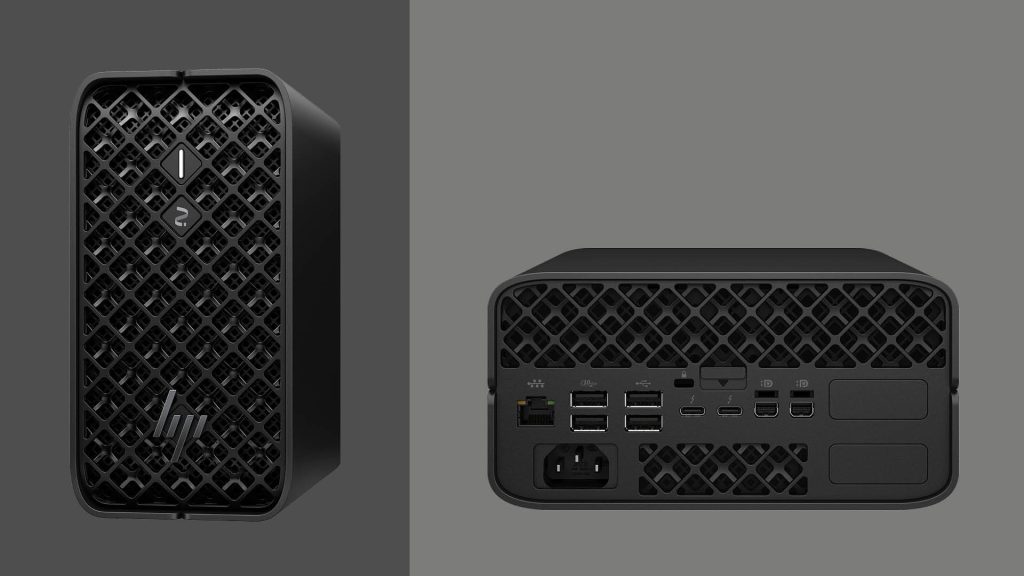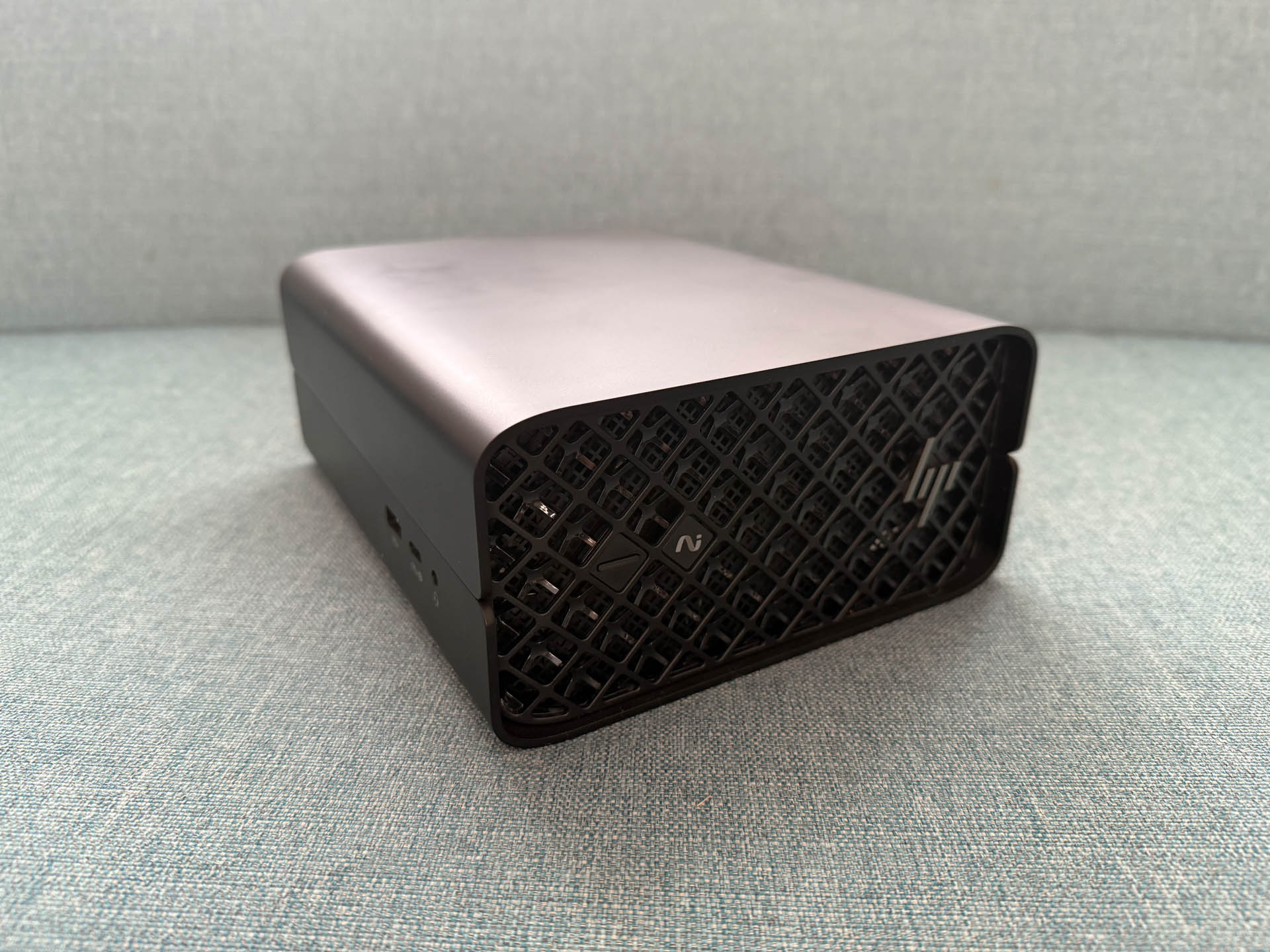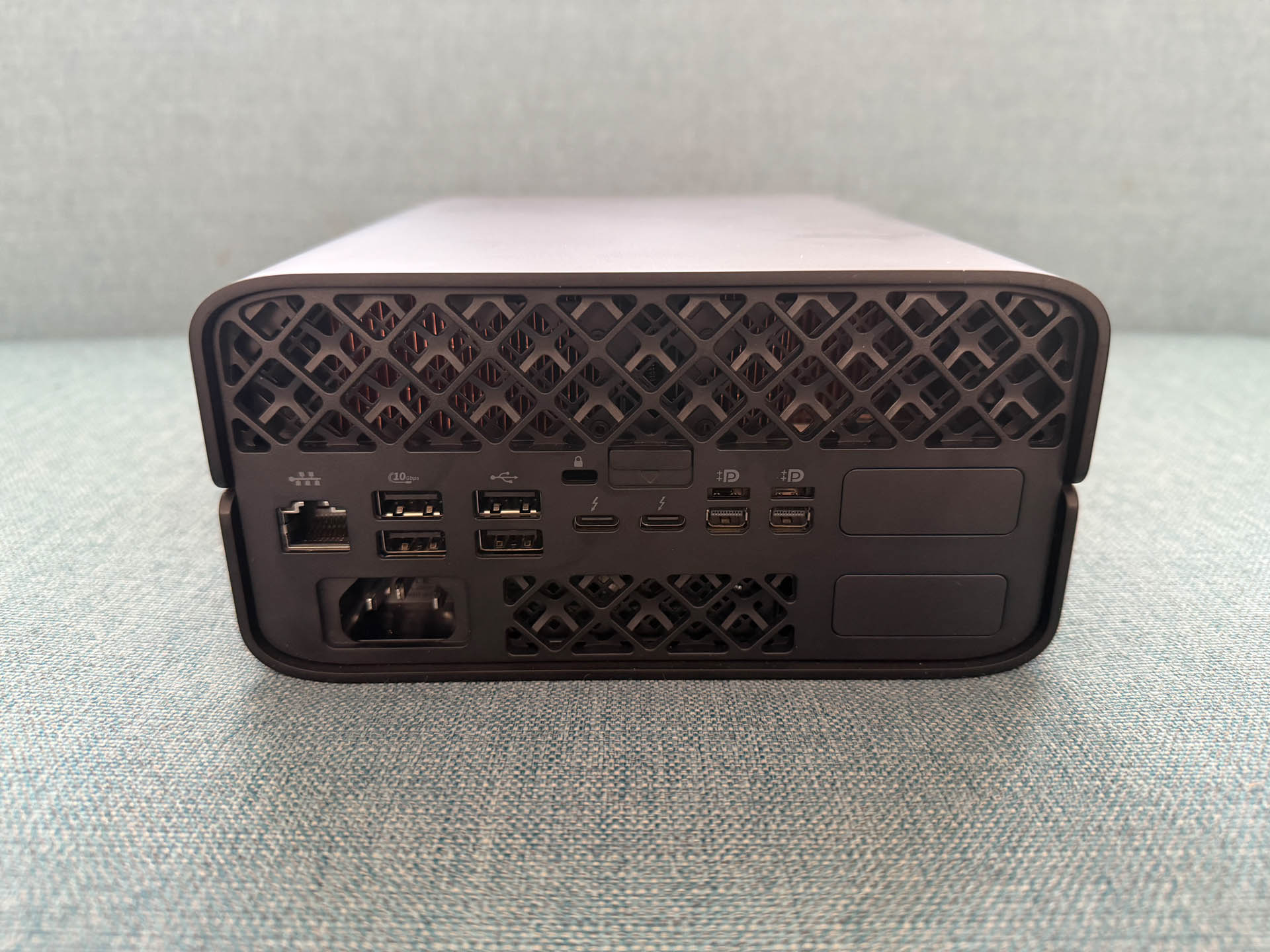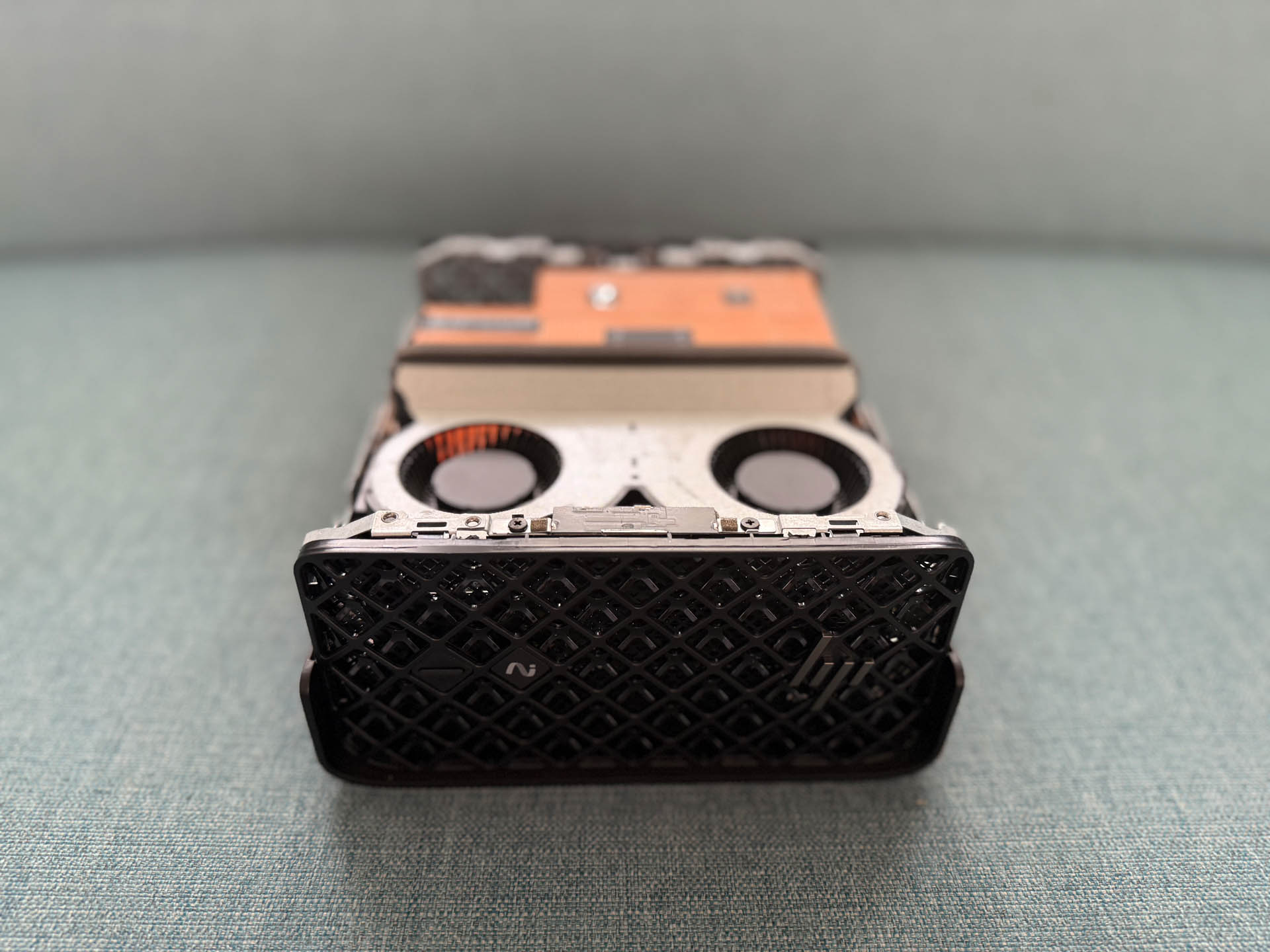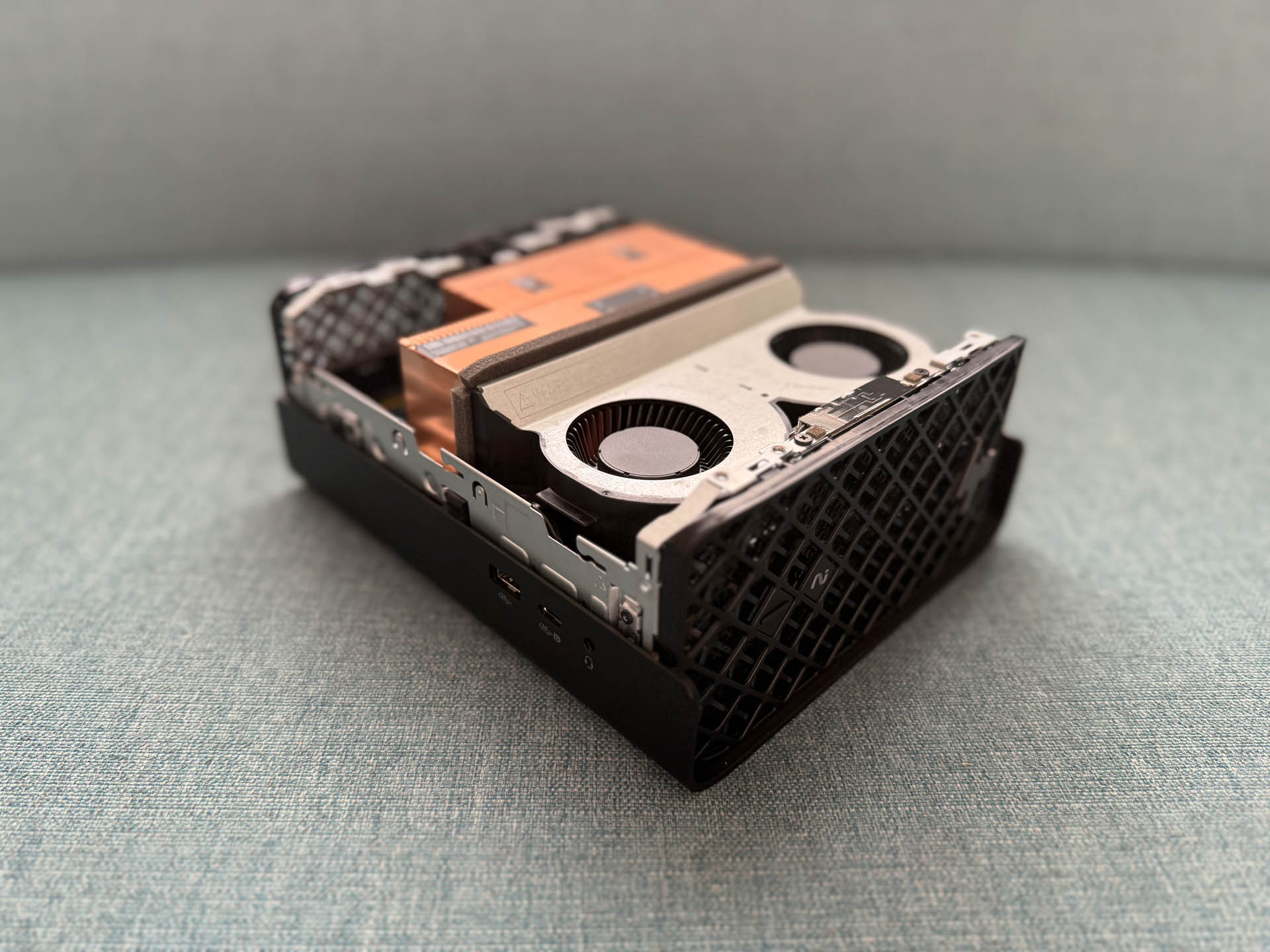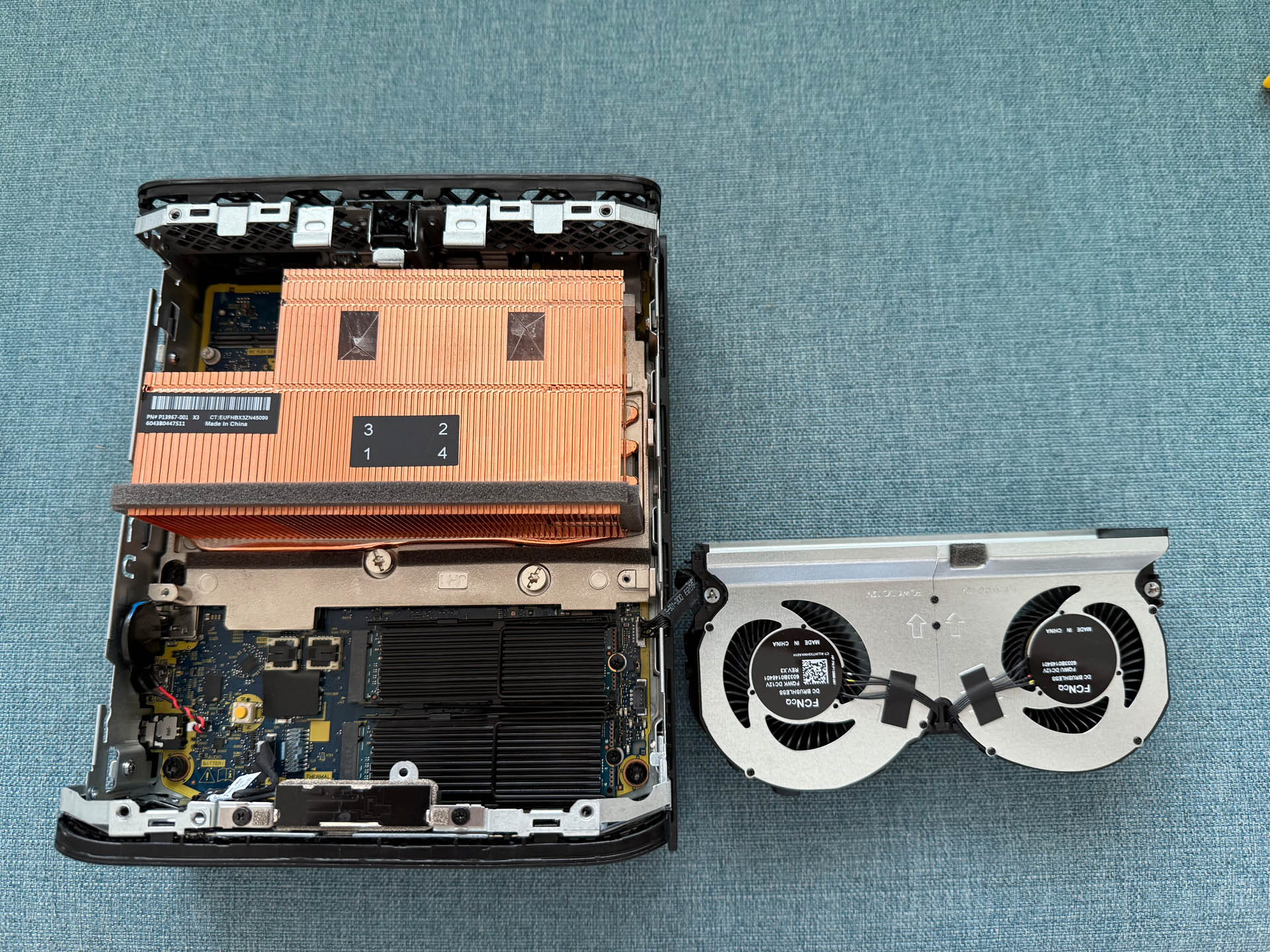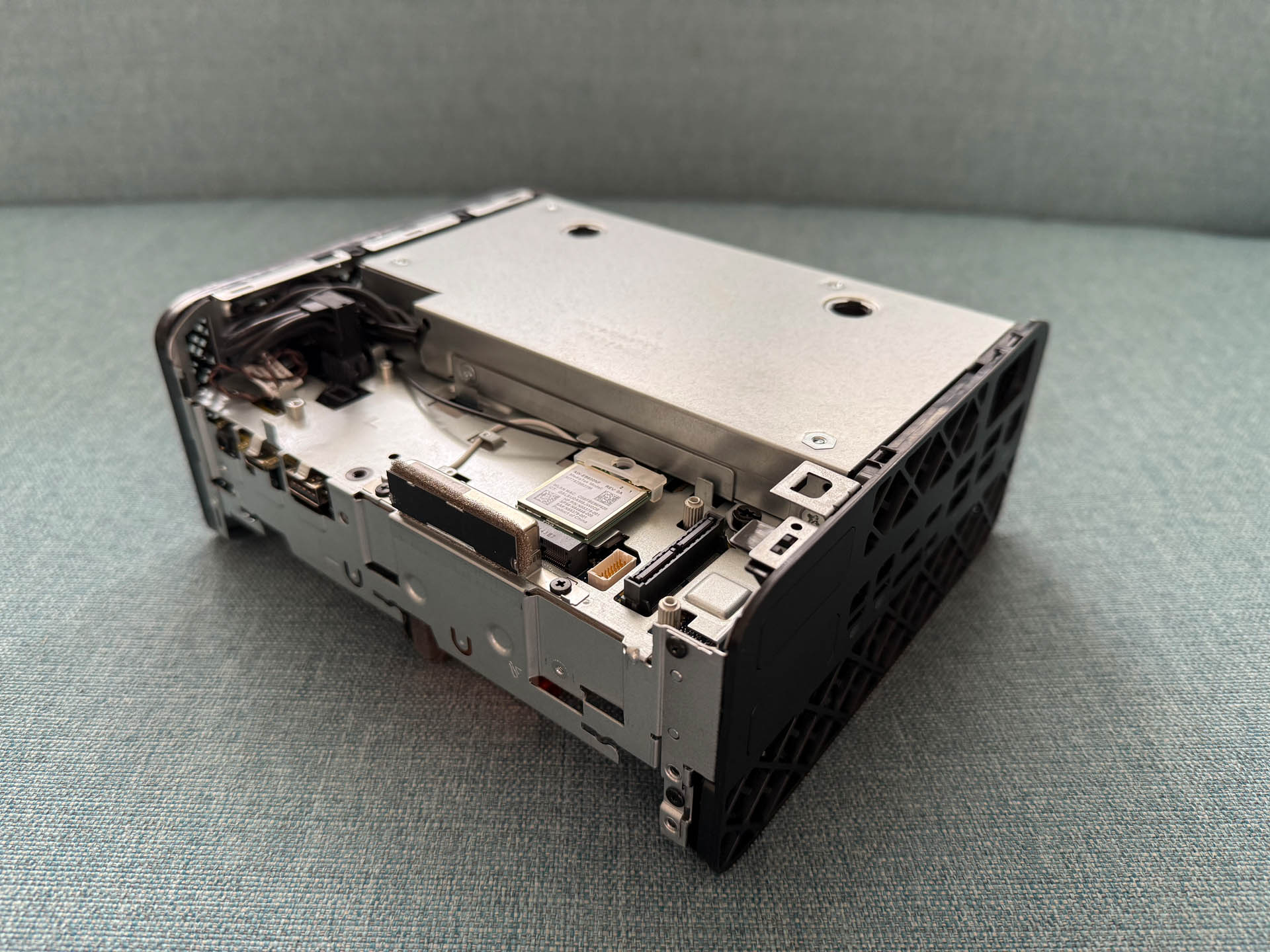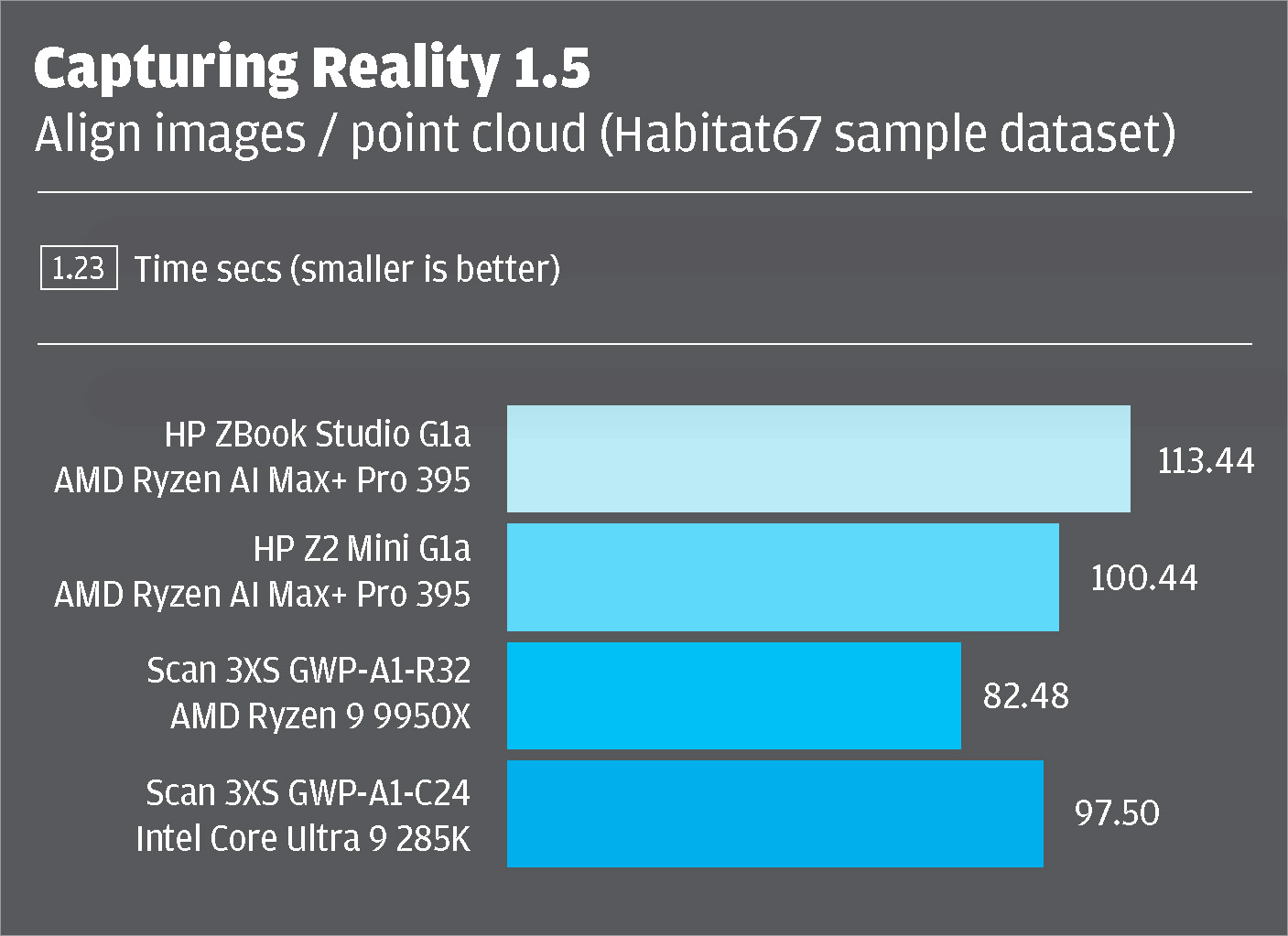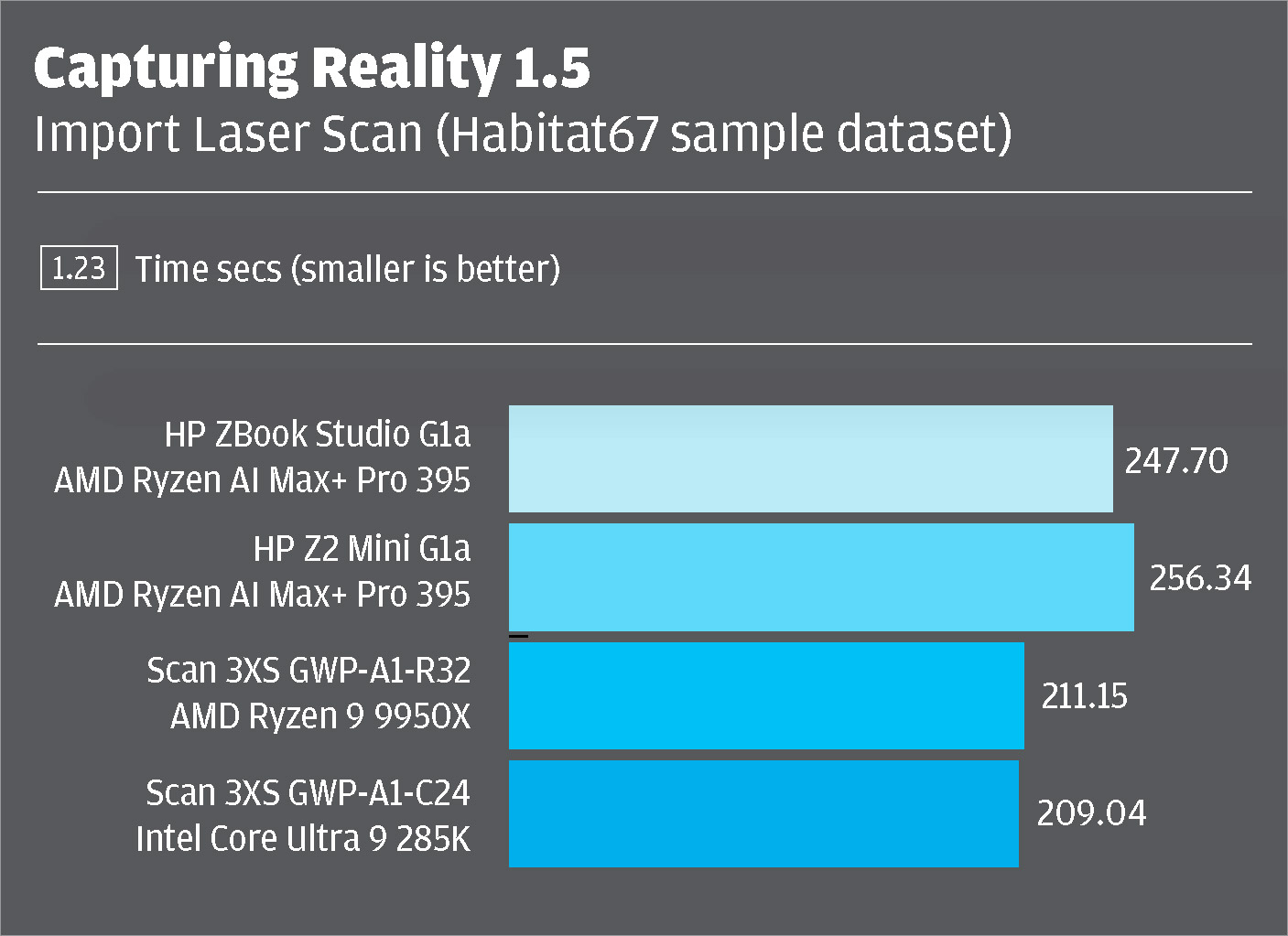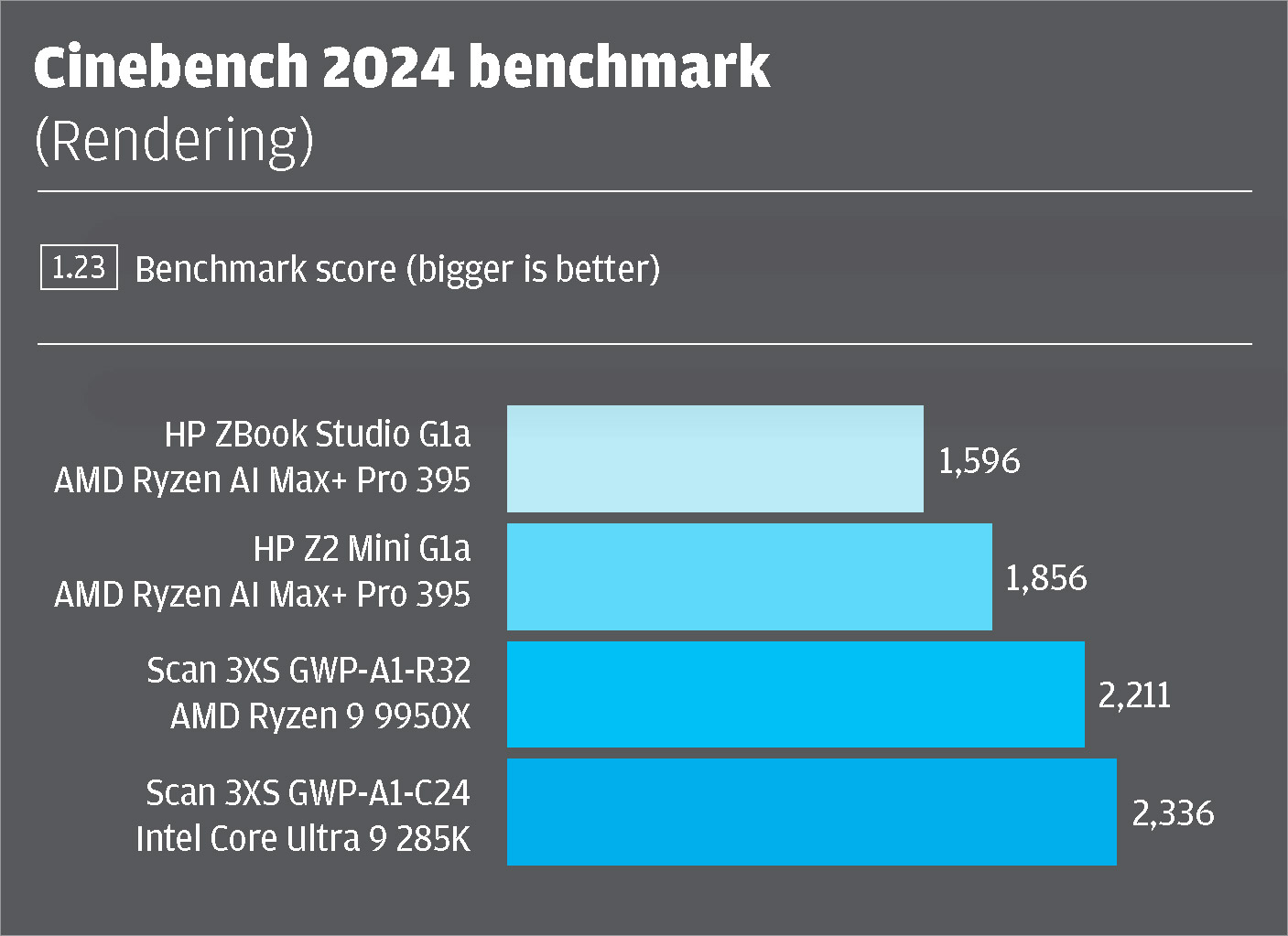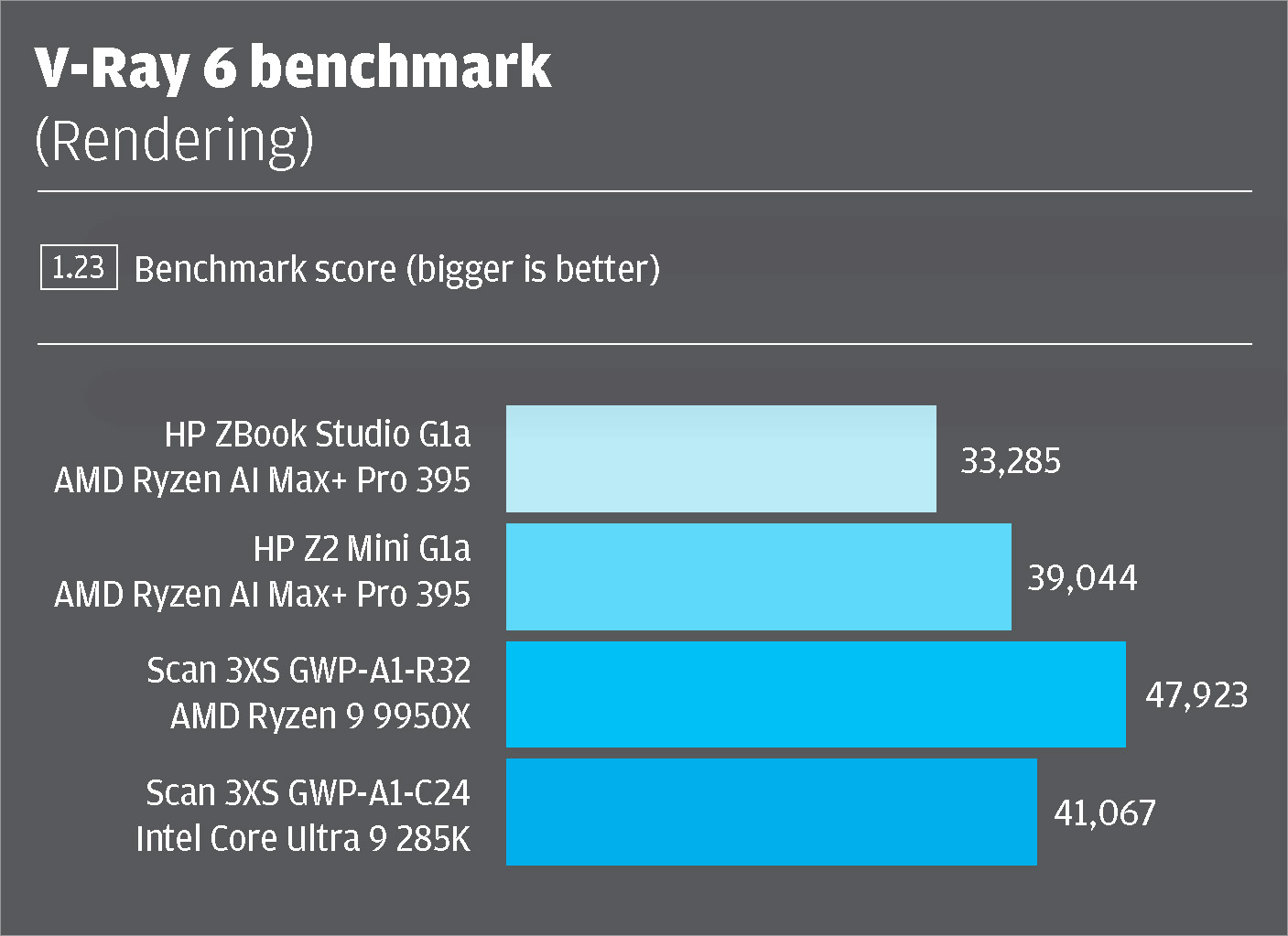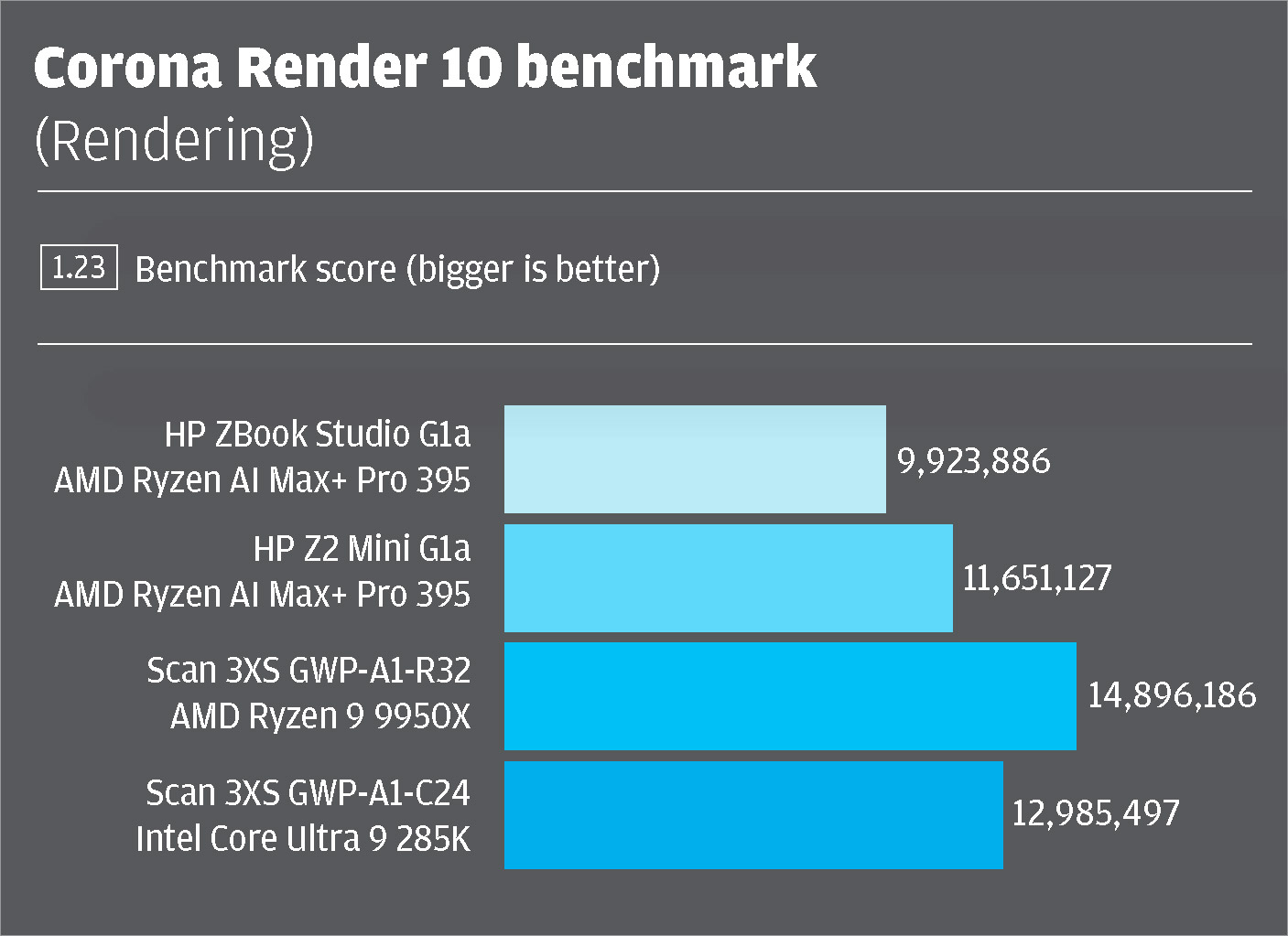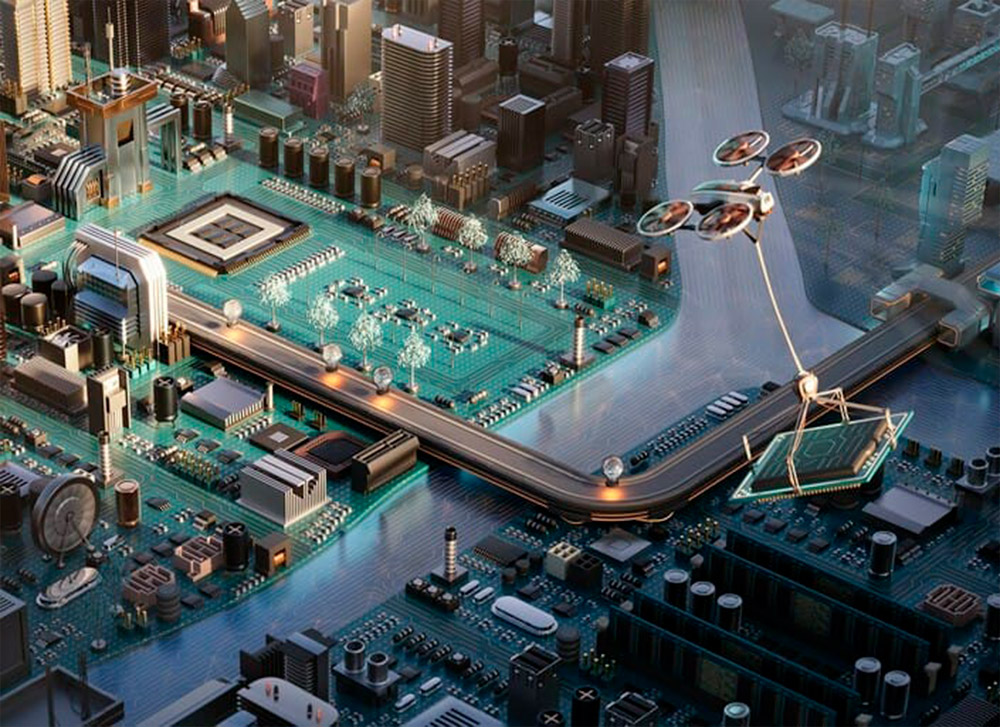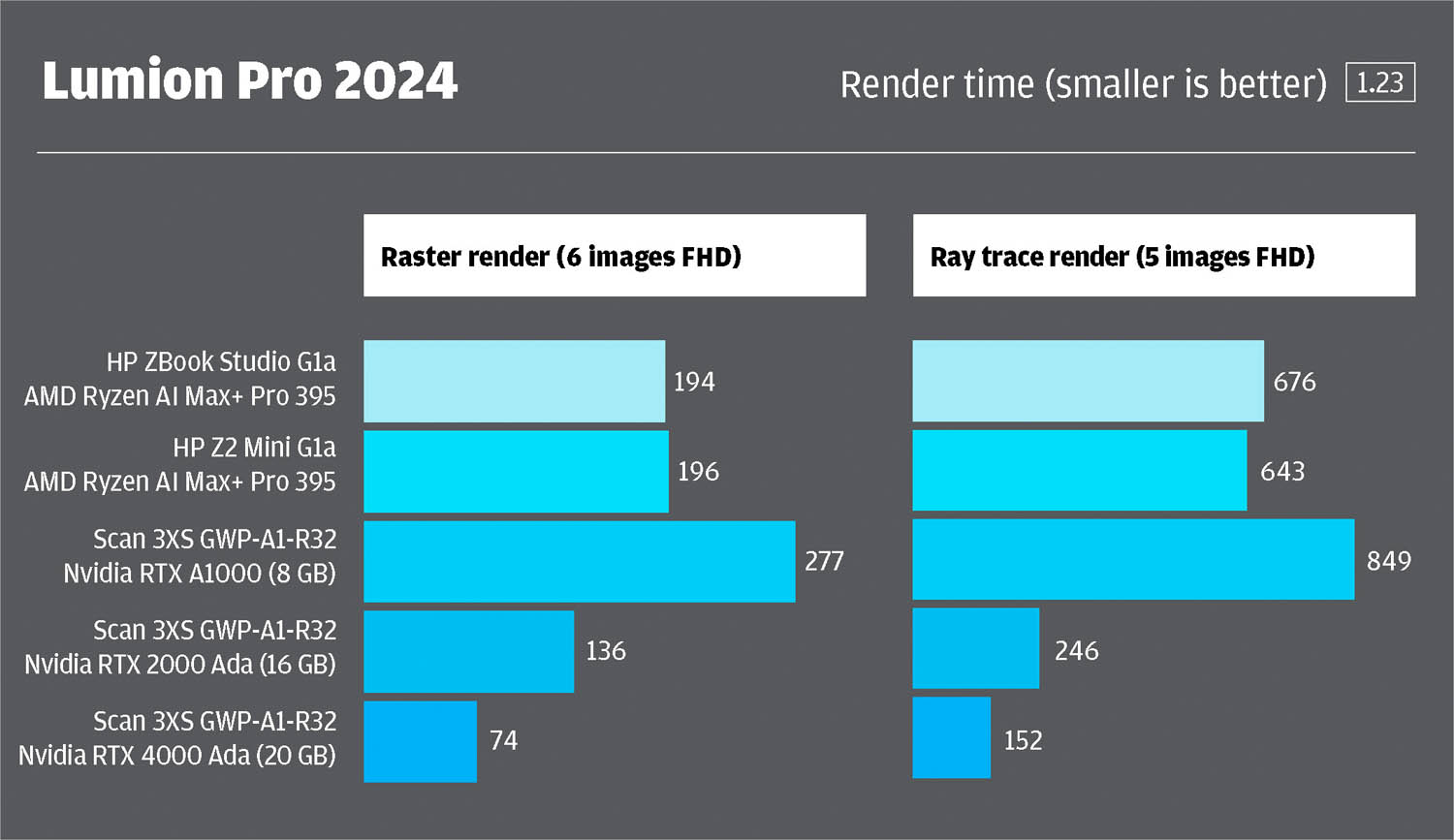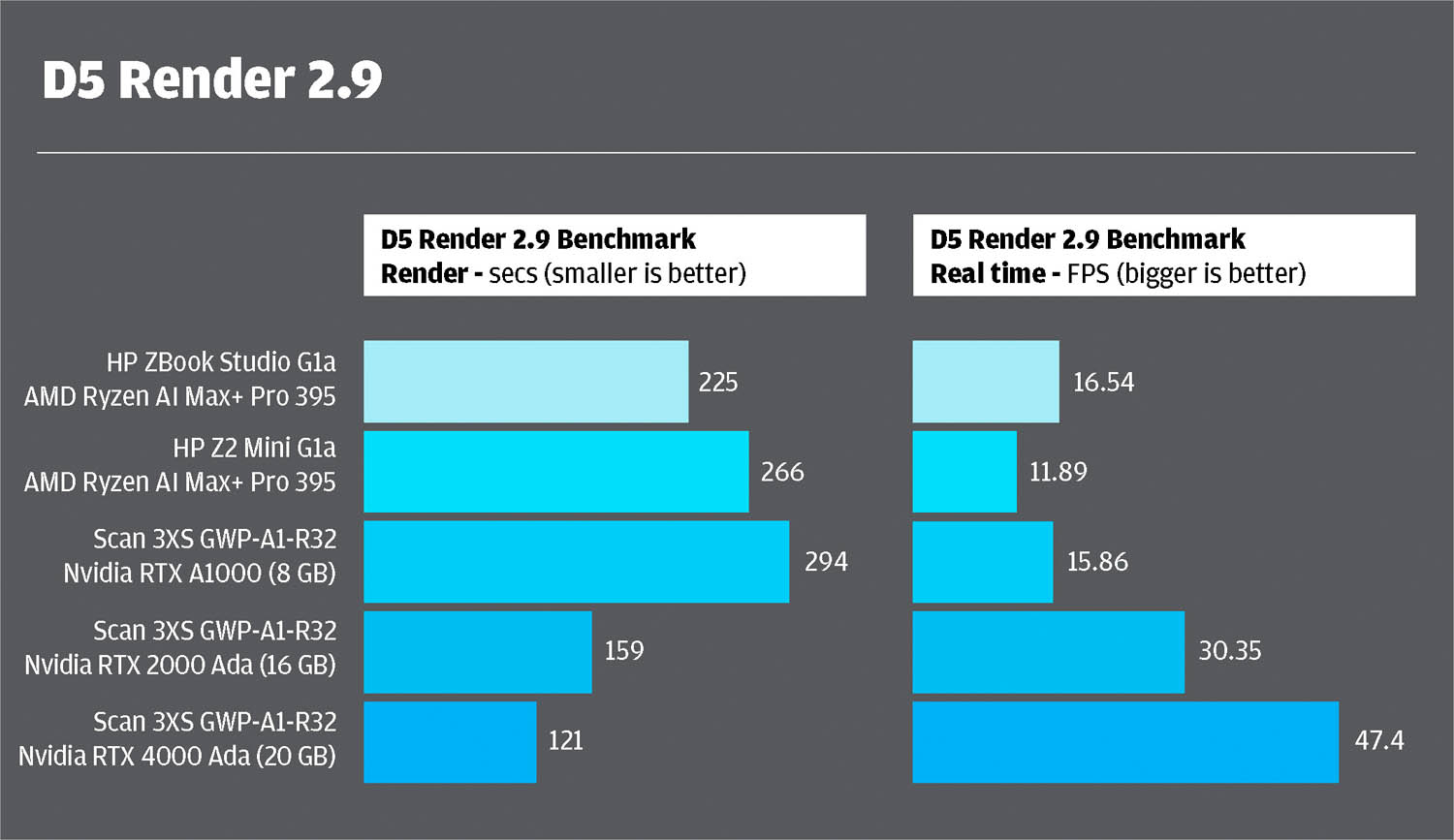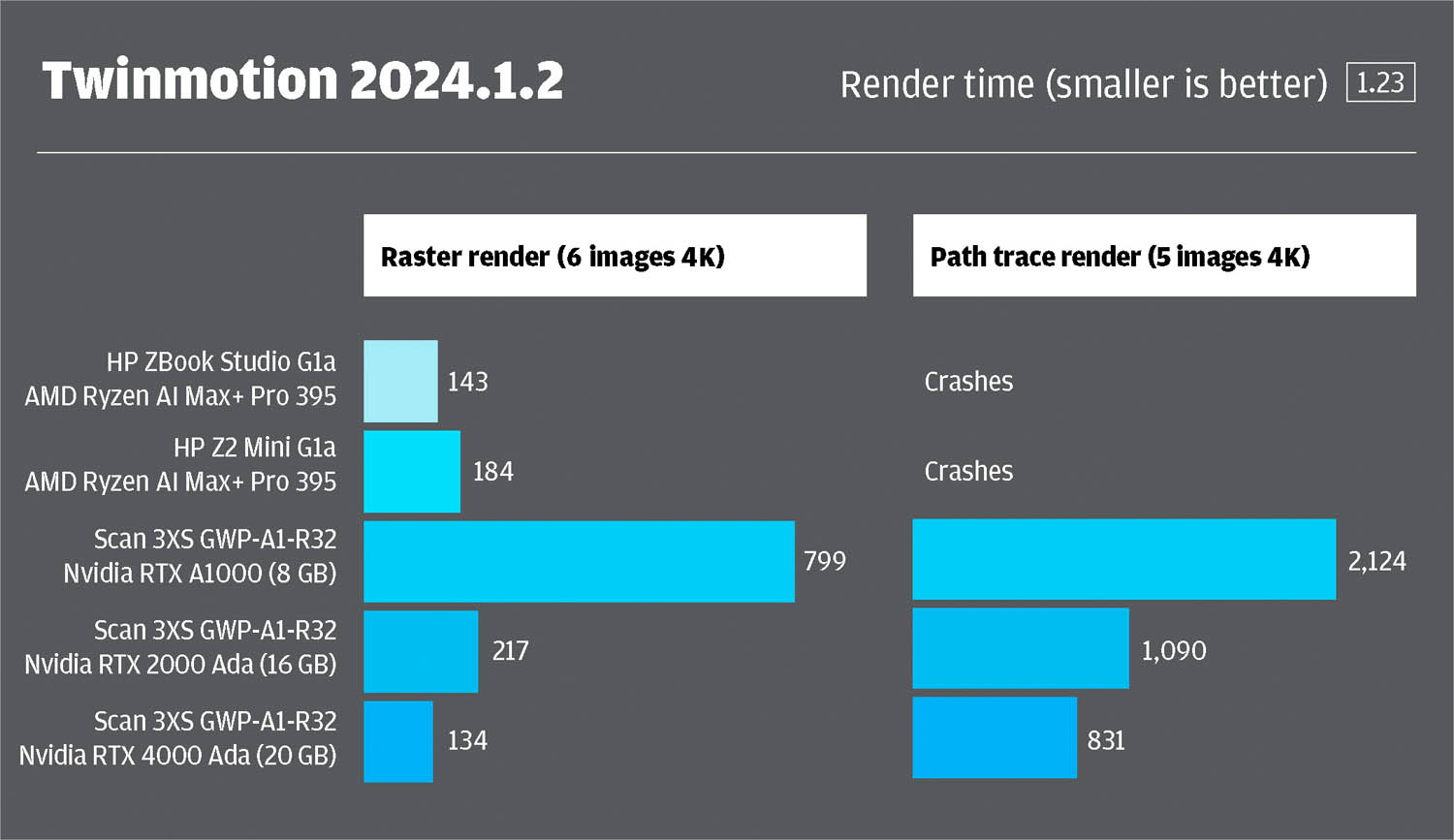With an integrated graphics processor with fast access to more memory than any other GPU in its class, HP is rewriting the rulebook for compact workstations, writes Greg Corke
When the HP Z2 Mini first launched in 2017 it redefined the desktop workstation. By delivering solid performance in an exceedingly compact, monitor-mountable form factor, HP created a new niche — a workstation ideal for space-constrained environments.
Fast forward several generations, and the Z2 Mini has evolved significantly. It’s no longer just a standalone desktop — it’s become a key component of HP’s datacentre workstation ecosystem, providing each worker with remote access to a dedicated workstation over a 1:1 connection.
With the latest model, the Z2 Mini G1a, HP introduces something new: an AMD processor at the heart of the machine, denoted by the ‘a’ suffix in its product name. This is the first time the Z2 Mini has featured AMD silicon, and the results are impressive.
The processor in question is the AMD Ryzen AI Max Pro, the exact same chip found in the hugely impressive HP ZBook Ultra G1a 14-inch mobile workstation, which we reviewed earlier this year.
Unlike traditional processors, this groundbreaking chip features an integrated GPU with performance on par with a mid-range discrete graphics card. Crucially, the GPU can also be configured with up to 96 GB of system memory. This far exceeds the memory ceiling of most discrete GPUs in its class and unlocks new possibilities for memory-intensive workloads, including AI.
While the ZBook Ultra G1a mobile workstation runs the Ryzen AI Max Pro within a 70 W thermal design power (TDP), the Z2 Mini G1a desktop cranks that up significantly — more than doubling the power budget to 150 W. This allows the chip to maintain higher clock speeds for longer, delivering more performance in both multi-threaded CPU workflows like rendering, simulation and reality modelling, as well as GPU-intensive tasks such as real-time visualisation and AI.
That said, doubling the power doesn’t double the performance. As with most processors, the Ryzen AI Max Pro reaches a point of diminishing returns, where additional wattage yields increasingly modest improvements. However, for compute-intensive workflows, that extra headroom can still deliver a meaningful advantage.
The compact workstation
The Z2 Mini G1a debuts with a brand-new chassis that’s even more compact than its Intel-based sibling, the Z2 Mini G1i. The smaller footprint is hardly surprising, given the AMD-based model doesn’t need room for a discrete GPU — unlike the Intel version, which currently supports options up to the double-height, low-profile Nvidia RTX 4000 SFF Ada Generation (read our review).
But what’s really clever is that HP’s engineers have also squeezed the power supply inside the machine. That might not seem like a big deal for desktops, but for datacentre deployments, where external power bricks and excess cabling can create clutter, interfere with airflow, and complicate rack management, it’s a significant improvement. Unfortunately, the HP Remote System Controller, which provides out-of-band management, is still external.
The chassis is divided into two sections, separated by the system board. The top two-thirds house the key components, fans and heatsink, while the bottom third is mostly reserved for the 300W power supply.
Despite its compact form factor, the Z2 Mini G1a doesn’t skimp on connectivity. At the rear you’ll find two Thunderbolt 4 ports (USB-C, 40Gbps), two USB Type-A (480Mbps), two USB Type-A (10Gbps), two Mini DisplayPort 2.1, and a 2.5GbE LAN. For easy access on the side, there’s an additional USB Type-C (10Gbps) and USB Type-A (10Gbps).
Serviceability on the Z2 Mini G1a is limited, as the processor and system memory are soldered to the motherboard, leaving no scope for major upgrades. It’s therefore crucial to select the right specifications at purchase (more on this later). The two M.2 NVMe SSDs and several smaller components, however, are easily replaceable, and two Flex I/O ports allow for additional USB connections or a 10GbE LAN upgrade.
The beating heart
The AMD Ryzen AI Max Pro processor at the heart of the Z2 Mini G1a is a powerful all-in-one chip that combines a high-performance multi-core CPU, with a remarkably capable integrated GPU and a dedicated Neural Processing Unit (NPU) for AI.
While the spotlight is understandably on the flagship model, the AMD Ryzen AI Max+ Pro 395, with a considerable 16 CPU cores and Radeon 8060S graphics capable of handling entry-level to mainstream visualisation, the other processor options shouldn’t be overlooked. With fewer cores and less powerful GPUs, they should still offer more than enough performance for typical CAD and BIM workflows (see table below).
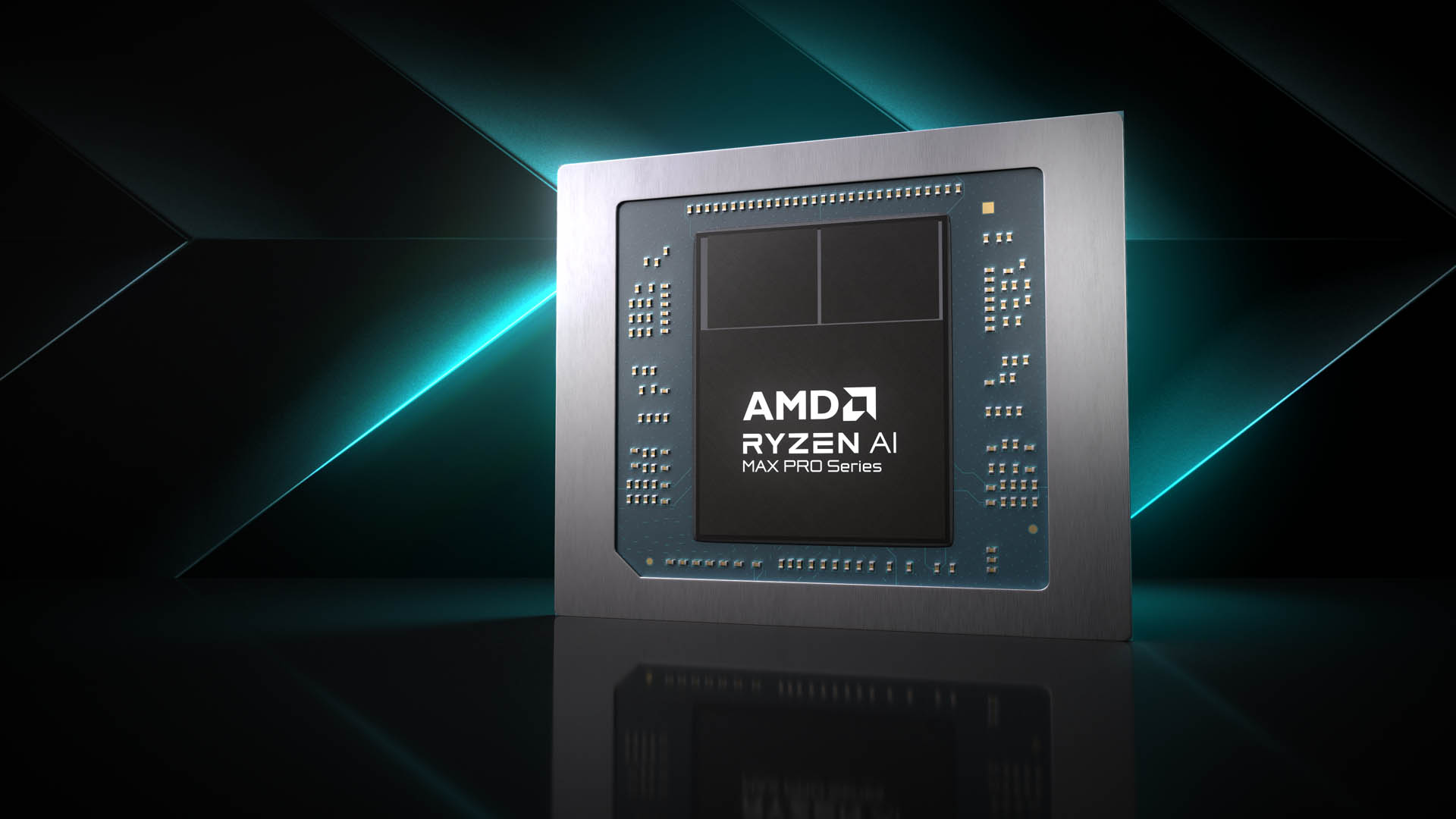
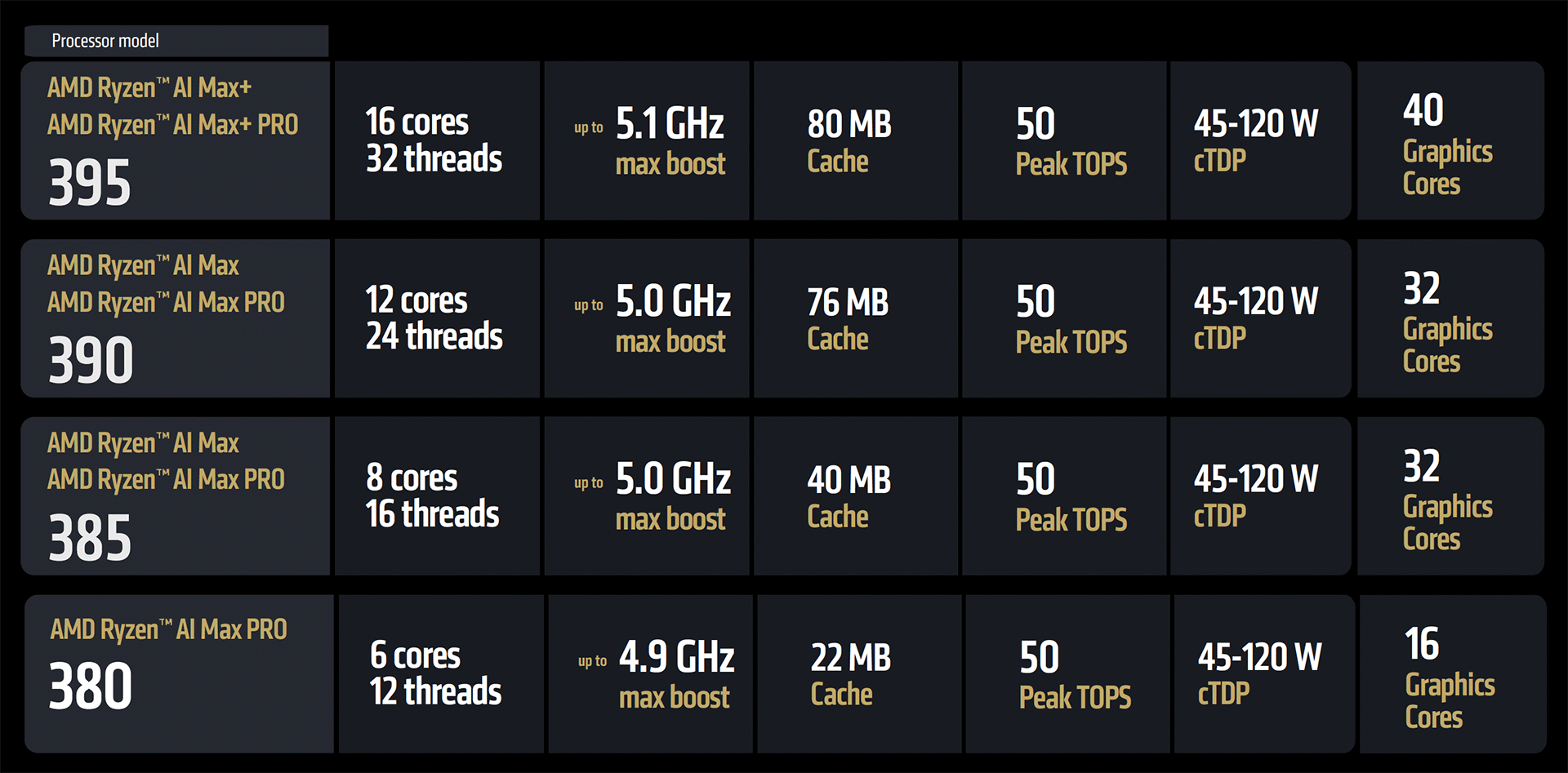
A massive pool of memory
The standout feature of the AMD Ryzen AI Max Pro is its memory architecture, and how it gives the GPU direct and fast access to a large, unified pool of system RAM. This is in contrast to discrete GPUs, such as Nvidia RTX, which have a fixed amount of on-board memory.
The integrated GPU can use up to 75% of the system’s total RAM, allowing for up to 96 GB of GPU memory when the Z2 Mini G1a is configured with its maximum 128 GB.
This means the workstation can handle certain workloads that simply aren’t possible with other GPUs in its class.
When a discrete GPU runs out of memory, it has to ‘borrow’ from system memory. Because this data transfer occurs over the PCIe bus, it is highly inefficient. Depending on how much memory is borrowed, performance can drop sharply: renders can take much longer, frame rates can fall from double digits to low single digits, and navigating models or scenes can become nearly impossible. In extreme cases, the software may even crash.
The Z2 Mini G1a allows users to control how much memory is allocated to the GPU. In the BIOS, simply choose a profile – from 512 MB, 4 GB, 8 GB, all the way up to 96 GB (should you have 128 GB of RAM to play with). Of course, the larger the profile, the more it eats into your system memory, so it’s important to strike a balance.
The amazing thing about AMD’s technology is that should the GPU run out of its ringfenced memory, in many cases it can seamlessly borrow more from system memory, if available, temporarily expanding its capacity. Since this memory resides in the same physical location, access remains very fast.
Even with the smallest 512 MB profile, borrowing 10 GB for CAD software Solidworks caused only a slight drop in 3D performance, maintaining that all-important smooth experience within the viewport.
This means that if system memory is in short supply, opting for a smaller GPU memory profile can offer more flexibility by freeing up RAM for other tasks.
Of course, because memory is fixed in the Z2 Mini G1a, and cannot be upgraded, you must choose very wisely at time of purchase. For CAD/BIM workflows, we recommend 64 GB as the entry-point with 128 GB giving more flexibility for the future, especially as AI workflows evolve (more on that later).
Performance testing
We put the Z2 Mini G1a to work in a variety of real-world CAD, visualisation, simulation and reality modelling applications. Our test machine was fully loaded with the top-end AMD Ryzen AI Max+ Pro 395 and 128 GB of system memory, of which 32 GB was allocated to the AMD Radeon 8060S GPU. All testing was done at 4K resolution.
We compared the Z2 Mini G1a with an identically configured HP ZBook Ultra G1a, primarily to assess how its 150 W TDP stacks up against the laptop’s more constrained 70 W. For broader context, we also benchmarked it against a range of desktop tower workstation CPUs and GPUs.
CPU tests
In single threaded workloads, we saw very little difference between the Z2 Mini G1a and ZBook Ultra G1a laptop. That’s because the power draw of a single CPU core remains well below 70W so there is no benefit from a larger TDP.
Both machines delivered very similar performance in both single threaded and lightly threaded tasks in Solidworks (CAD), laser scan import in Capturing Reality and the single core test in rendering benchmark Cinebench.
It was only in multi-threaded tests where we started to see a difference and that’s because the Z2 Mini G1a pushes the AMD Ryzen AI Max+ Pro 395 processor much closer to 150W. When rendering – a highly multi-threaded process that makes full use of all cores – the Z2 Mini G1a was around 16-17% faster in Corona Render 10, V-Ray 6.0, and Cinebench 2024.
Meanwhile, when aligning images and laser scans in Capturing Reality, it was around 11% faster. And in select simulation workflows in both SPECwpc benchmarks, the performance increase was as high as 82%!
But how does the Z2 Mini G1a stack up against larger desktop towers? AMD’s top-tier mainstream desktop processor, the Ryzen 9 9950X, shares the same Zen 5 architecture as the Ryzen AI Max+ Pro, but delivers significantly better performance. It’s 22% faster in Cinebench, 18% faster in Capturing Reality, and 15–33% faster in Solidworks. But that’s hardly surprising, given it draws up to 230W, as tested in a Scan 3XS tower workstation with a liquid cooler and heatsink roughly the size of the entire Z2 Mini G1a!
We saw similar from Intel’s flagship Core Ultra 9 285K in a Scan 3XS tower, which pushes power even further to 253W. While this Intel chip is technically available as an option in the HP Z2 Mini G1a’s Intel-based sibling, the HP Z2 Mini G1i, it would almost certainly perform well below its full potential due to the power and thermal limits of the compact chassis.


GPU tests
The Z2 Mini G1a’s 150W TDP pushes the Radeon 8060S GPU harder, outperforming the ZBook Ultra G1a in several demanding graphics workloads.
The Z2 Mini G1a impressed in D5 Render, completing scenes 15% faster and delivering a 39% boost in real-time viewport frame rates. Twinmotion also saw a notable 22% faster raster render time, though in Lumion, performance remained unchanged.
The biggest leap came in AI image generation. In the Procyon AI benchmark, the Z2 Mini G1a was 50% faster than the ZBook Ultra G1a in Stable Diffusion 1.5 and an impressive 118% faster in Stable Diffusion XL.
But how does the Radeon 8060S compare with discrete desktop GPUs like the low-profile Nvidia RTX A1000 (8 GB) and RTX 2000 Ada Generation (16 GB), popular options in the Intel-based Z2 Mini G1i?
In the D5 Render benchmark, which only requires 4 GB of GPU memory, the Radeon 8060S edged ahead of the RTX A1000 but lagged behind the RTX 2000 Ada Generation.
Its real advantage appears when memory demands grow: with 32 GB available, the Radeon 8060S can handle larger datasets that overwhelm the RTX A1000 (8 GB) and even challenge the RTX 2000 Ada Generation (16 GB) in our Twinmotion raster rendering test. Path tracing in Twinomtion, however, caused the AMD GPU to crash, highlighting some of the broader software compatibility challenges faced by AMD, which we explore in our ZBook Ultra G1a review.
Meanwhile, in our Lumion test, which only needs 11 GB for efficient rendering at FHD resolution, the RTX 2000 Ada Generation (16 GB) demonstrated a clear performance advantage.
Of course, while the Radeon 8060S allows large models to be loaded into memory, it’s still an entry-level GPU in terms of raw performance and complex viz scenes may stutter to a few frames per second. Waiting for renders may be acceptable to architects, but laggy viewport navigation is not.
Overall, the Radeon 8060S shines when memory capacity is the limiting factor, but it cannot match higher-end discrete GPUs in sustained rendering performance. For more on these trade-offs, see our review of the HP ZBook Ultra G1a.
Gently does it
Out of the box, the Z2 Mini G1a is impressively quiet when running CAD and BIM software. Fan noise becomes much more noticeable under multithreaded CPU workloads and, to a lesser extent, GPU-intensive tasks. The good news is that this can be easily managed without significantly impacting performance: in the BIOS, users can select from four performance modes — ‘high-performance,’ ‘performance,’ ‘quiet,’ and ‘rack’ — which operate independently of the standard Windows power settings.
The HP Z2 Mini G1a ships with ‘high performance’ mode enabled by default, allowing the processor to run at its full 150W TDP. In V-Ray rendering, it maintains an impressive all-core frequency of 4.6 GHz, although the fans ramp up noticeably after a minute or so.
Switching to Quiet Mode (after a reboot) prioritises acoustics over raw performance. The CPU automatically downclocks, and fan noise becomes barely audible — even during extended V-Ray renders. For short bursts, such as a one-minute render, the system still delivers 140W with a minimal frequency drop. Over a one-hour batch render, however, power levels dipped to 120W, and clock speeds averaged around 4.35 GHz.
The good news: this appeared to have negligible impact on performance, with V-Ray benchmark scores falling by just 1% compared to High Performance mode. In short, Quiet Mode looks to be more than sufficient for most workflows, offering near-peak performance with significantly reduced fan noise.
Finally, Rack Mode prioritises reliability over acoustics. Fans run consistently — even at idle — to ensure thermal stability in densely packed datacentre deployments.
Local AI
Most AEC firms will use the Z2 Mini G1a for everyday tasks — your typical CAD, BIM, and visualisation workflows. But thanks to the way the GPU has access to a large pool of system memory, it also opens the door to some interesting AI possibilities.
With 96 GB to play with the Z2 Mini G1a can take on much bigger AI models than a typical discrete GPU with fixed memory. In fact, AMD recently reported that the Ryzen AI Max Pro can now support LLMs with up to 128 billion parameters — about the same size as Chat GPT 3.0.
This could be a big deal for some AEC firms. Previously, running models of this scale required cloud infrastructure and dedicated datacentre GPUs. Now, they could run entirely on local workstation hardware. AMD goes into more detail in this blog post and FAQ.
Of course, the AMD Ryzen AI Max Pro won’t even get close to matching the performance of a high-end Nvidia GPU, especially one in the cloud. But in addition to cost, the big attraction is that you could run AI locally, under your full control, with no data ever leaving your network.
On a more practical level for AEC firms experimenting with text-to-image AI for early-stage design, AMD also explains that the Ryzen AI Max+ can handle text-to-image models with up to 12 billion parameters, like FLUX Schnell in FP16. This could make it attractive for those wanting more compelling, higher resolution visuals, if they are willing to wait for the results.
Finally, thanks to the Ryzen AI Max Pro’s built-in NPU, there’s also dedicated AI hardware for efficient local inference as well. And at 50 TOPS the NPU is more powerful than other desktop workstation NPUs, and the only one we know that meets Microsoft’s requirements for a CoPilot+ PC.
The verdict
The HP Z2 Mini G1a represents a major step forward for compact workstations, delivering strong performance and enabling new workflows in a datacentre-ready form factor.
At its heart the AMD Ryzen AI Max Pro processor not only delivers a powerful multi-core CPU and remarkably capable integrated GPU, but an advanced memory architecture as well that allows the GPU to tap directly into a large pool of system memory — up to 96 GB.
This makes the Z2 Mini G1a stand out from traditional discrete GPU-based workstations — even some with much larger chassis — by offering an advantage in select memory-intensive workloads, from visualisation to advanced AI.
Of course, the Ryzen AI Max Pro is no silver bullet. While the 16-core chip delivers impressive computational performance, AMD faces tough competition from Nvidia on the graphics front – both in terms of hardware and software compatibility.
Nvidia’s recently announced low-profile Blackwell GPUs offer improved performance and more memory (up to 24 GB) and are expected to debut soon in the HP Z2 Mini G1i.
As reviewed, the Z2 Mini G1a with the AMD Ryzen AI Max+ Pro 395 and 128 GB RAM is priced at £2,280 + VAT, while a lower-spec model with the Ryzen AI Max Pro 390 and 64 GB RAM (our recommended minimum) comes in at £1,710 + VAT.
While this isn’t exactly cheap, pricing is competitive given the performance and workflows potential on offer. More than anything, the Z2 Mini G1a shows how far compact workstations have come — delivering desktop and datacentre power in a form factor that was once considered a compromise.

